Log management plays a vital role in unlocking valuable insights into an application's architecture by encompassing log data storage, processing, analysis, and visualization. By leveraging log management tools, you can monitor performance trends, troubleshoot issues, detect anomalies, and optimize overall system performance. This holistic understanding enables proactive decision-making and the maintenance of a secure infrastructure.
In recent times, open-source log management solutions have gained significant traction as organizations seek flexible and cost-effective ways to manage the large volumes of log data typical for modern systems. These tools provide a compelling alternative to commercial offerings, empowering businesses of all sizes to effectively manage log data, extract actionable insights, and enhance system performance.
Embracing open-source log management not only provides cost savings but also opens avenues for greater flexibility, customization, and community-driven innovation
In this article, we will discuss six open-source log management tools that offer flexible and cost-effective solutions for effectively managing log data in production environments. We will explore their capabilities, pros, cons, and potential use cases of each one so that you can decide the right solution for your business.
Let’s get started!
1. OpenObserve
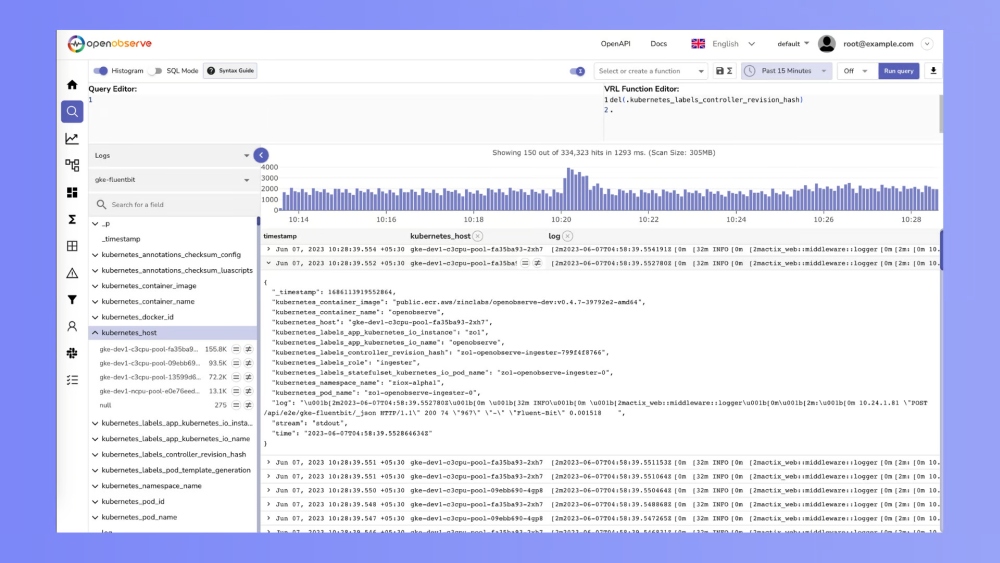
OpenObserve is a Rust-based open source platform that can handle all your observability needs through its support for logs, metrics, and traces. Its aim is to provide one platform that replaces Prometheus for metrics, Elasticsearch for logs, Jaeger for traces, and Grafana for dashboards, and it advertises up to 140x lower storage costs compared to Elasticsearch due to its compatibility with storage services such as S3, GCS, Minio, and Azure Blob.
With OpenObserve, you do not need to learn a new query language to query logs because it supports SQL as its primary query language for logs and traces, as well as PromQL for querying metrics data. It is also very easy to install and operate, and it also needs less resources to run due to its Rust-based infrastructure.
It also offers an intuitive and easy-to-navigate GUI that allows you to manage and visualize the various observability data that you're collecting. At ingest or query time, you can enrich, parse, redact sensitive data, and remove unwanted parts of logs so that only the relevant bits are left.
OpenObserve's also provides a built-in alerting mechanism, which can dispatch alerts to channels such as Slack, Microsoft Teams, and many others. It also supports collaboration between team members, and uses Role-based Access Control (RBAC) to control access to data based on a team member's level, ensuring the overall security of your data.
OpenObserve pros
- Provides logs, metrics, traces, dashboards, alerts, and functions support in a single package.
- Generous free plan with 200 GB Ingestion/month and 15-day retention.
- Supports SQL for log querying and PromQL for metrics.
- Role-based access control for teams.
- Storage cost is much lower due to its efficient data storage process.
- Written in Rust for high performance.
OpenObserve cons
- Being a relatively new product, it is not as battle tested as other solutions that have been around for a longer period.
- Support for logs and traces is more mature than metrics at the time of writing.
2. Grafana Loki
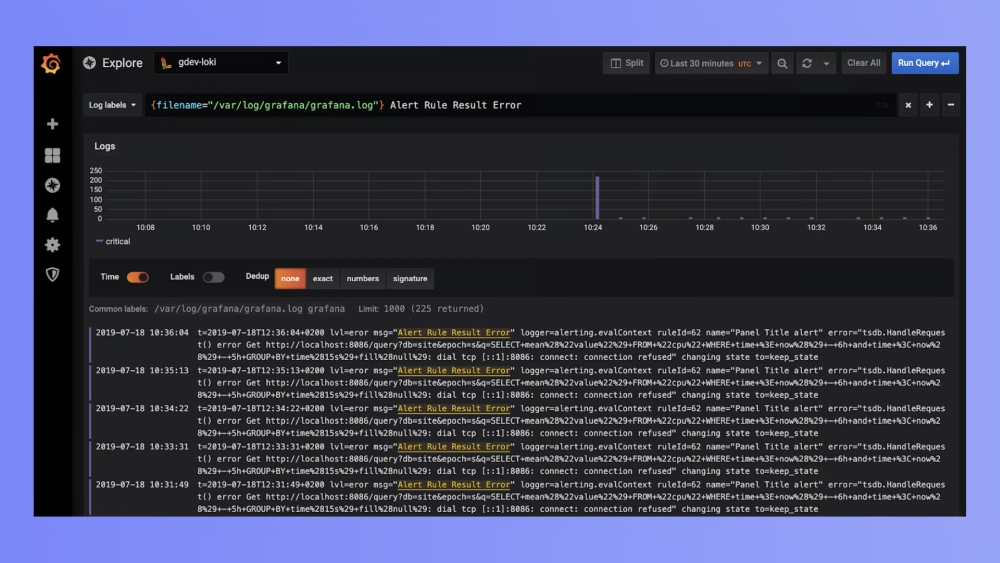
Loki is a log management system that is produced by the made by the Grafana team under the open source AGPLv3 license. It is unique due to its log storage mechanism which indexes only the labels and metadata from each log stream and not the contents of the logs. This allows it to require less storage and also process log messages more quickly. The downside of this, however, is that it is less sophisticated or straightforward in its log searching capabilities compared to other platforms.
It works by pulling logs through an HTTP API through Promtail, the log collector built specifically for Loki. The logs are then grouped into streams and indexed with labels, but the text of the logs are not indexed to improve performance and reduce storage costs. Once the logs are in Loki, they can be explored using LogQL, Loki's query language. It also seamlessly integrates with Grafana for displaying various insights generated from log data through its customizable dashboards.
Loki also provides a powerful alerting system. You can create rules that will be triggered when certain conditions are met, then send them to Prometheus AlertManager, which will then route them to the appropriate destination. This ensures that critical issues are quickly identified and addressed promptly.
There are 3 options for deploying Grafana Loki:
- Completely self-hosted with support provided by the community.
- Using Grafana Cloud's managed service which has a free tier of 50GB log ingestion per month.
- Enterprise self-hosted with support provided by the Grafana Labs team.
Loki pros
- Loki is designed to be cost-effective and scales well for large-scale log aggregation. It uses storage-efficient techniques, like indexing and chunking, to optimize resource utilization.
- As a part of the Grafana ecosystem, it integrates seamlessly with Grafana dashboards and alerts, providing a unified observability experience for metrics and logs.
- Seamless integration with Prometheus for metrics and alerting.
- It can scale horizontally, allowing you to add more nodes to handle increasing log volume without significant disruptions.
- Loki supports multi-tenancy, making it suitable for environments with multiple users or teams.
- Loki's design allows it to operate with relatively low resource requirements compared to other log aggregation solutions.
- If you're using Loki through Grafana Cloud, it has a generous free tier of 10K metrics + 50GB logs + 50GB traces.
Loki cons
- It is optimized for real-time and recent log data. While it is possible to extend retention using other storage solutions, it might add complexity to the setup.
- It has a limited feature-set compared to established solutions like Elasticsearch and Splunk.
- Indexing is sometimes resource intensive during heavy write loads.
- Some learning may be required to understand its query language, LogQL.
Read more about Grafana alternatives.
3. SigNoz
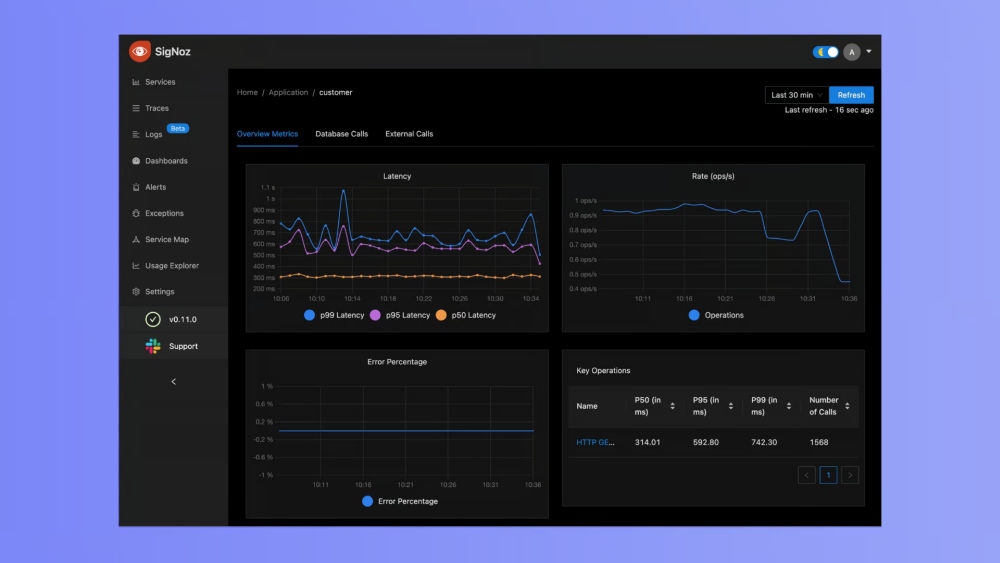
SigNoz is a log collection and analysis tool that can collect and manage logs, metrics, traces and exceptions from a variety of sources. It provides native support for instrumenting your applications with OpenTelemetry to prevent vendor lock-in, stores the collected data in ClickHouse and then aggregates and visualizes the data in a user-friendly dashboard.
With SigNoz, you can easily set dynamic thresholds for alerts using its Query Builder, PromQL, or ClickHouse queries. Its Query Builder simplifies the process of searching and filtering logs, and any triggered alerts will send you a notification via channels like Slack, PagerDuty, and others.
SigNoz also supports integration with popular frameworks and technologies, making it compatible with a wide range of application stacks. This allows you to proactively monitor and optimize your various services to improve their performance, troubleshoot and fix issues faster, and enhance their overall reliability.
Built with a modular architecture, SigNoz can effortlessly scale to accommodate your growing needs. You have the flexibility to define your own retention period and sampling rate, optimizing data storage costs based solely on application load.
SigNoz pros
- Provides good defaults. You can install it in your Kubernetes cluster and start collecting logs and metrics immediately.
- Offers charts and visualization out of the box.
- Automatically calculates important metrics like error rate and 99 percentile.
- Native support for instrumentation with OpenTelemetry which helps vendor lock-in.
- Dynamic alerting thresholds can be easily set, and the resulting notifications are timely.
SigNoz cons
- The documentation can be unclear, as it mainly covers storage and retention period configurations.
- Upgrades can sometimes break things.
- Unified dashboards are not currently available.
- Limited customizability.
4. Graylog
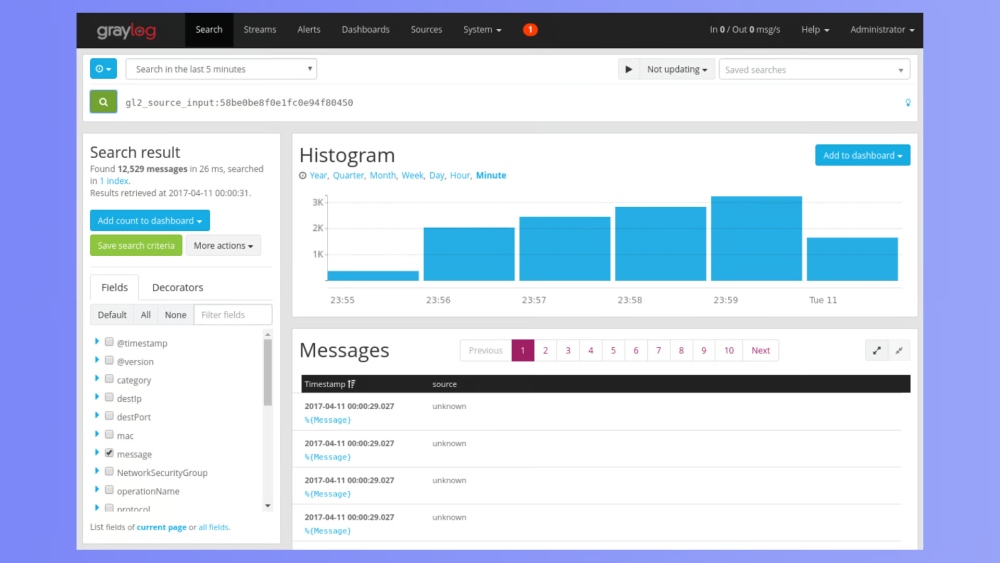
Graylog is an open source log management platform that streamlines the process of collecting, storing, and analyzing log data. It collects logs from diverse sources, parses and enriches them, and then stores them in a database for future analysis. Just as it supports multiple input sources, it is capable of forwarding the collected data to other systems such as Elasticsearch.
With Graylog's sophisticated search capabilities, you can swiftly navigate through terabytes of data in milliseconds, and you can even save search queries for future use. Its customizable dashboards offers clear visualizations of your essential metrics and data, providing a comprehensive overview of your application activity. Moreover, you can effortlessly create and schedule formal reports, which are automatically delivered to your inbox.
Graylog also excels in proactive monitoring by allowing periodical searches that trigger notifications when predefined conditions are met. These alert thresholds can be easily configured, by specifying the time frame and frequency of searches. You also can enhance your alert conditions and other business use cases by leveraging plugins available in the Graylog Marketplace.
Graylog pros
- Offers team collaboration features.
- Sleek and user-friendly interface.
- Capable of ingesting logs from various sources.
- Fast and sophisticated log searching.
- Support for customizable alert thresholds.
Graylog cons
- Deployment requires considerable effort.
- Plugin installation and optimization can prove challenging.
Read more about Graylog alternatives.
5. Syslog-ng
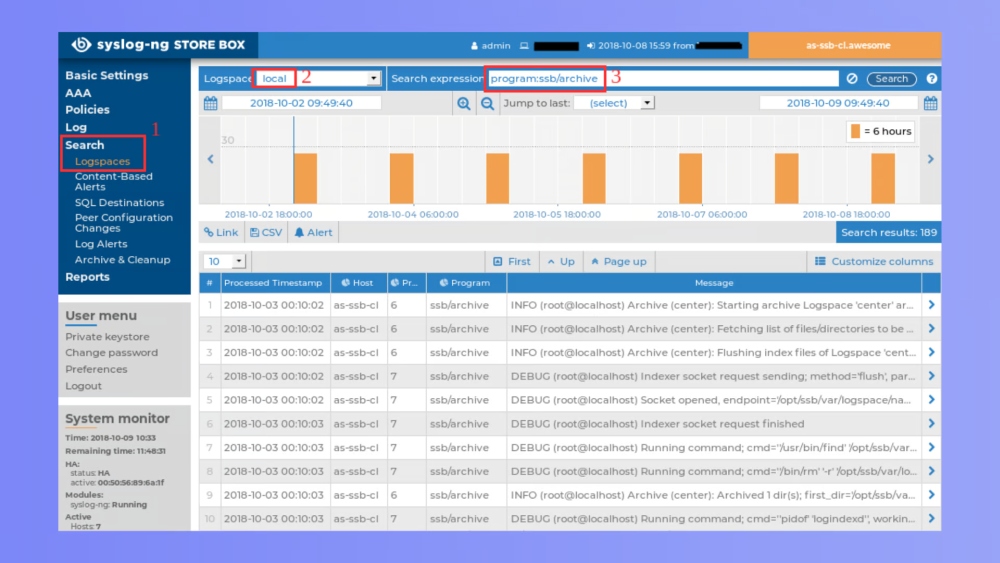
This high-performance log management tool is a flexible solution for collecting, analysing and storing logs. It allows you to gather data from a wide range of sources, then parse, classify, rewrite and correlate the logs into a unified format, and then either store or securely transfer them to different systems like Apache Kafka or Elasticsearch. This eliminates the need for you to deploy multiple agents as it allows you to carry out all your data management processes in one place.
Syslog-ng offers rapid search and troubleshooting, as well as complex filtering using regular expressions and boolean operators, allowing you to easily locate, filter and parse log messages in real-time. This makes for quick extraction of critical information and, as a result, faster troubleshooting and issue resolution. Leveraging its multi-thread processing structure, Syslog-ng achieves exceptional performance, processing over 500k log messages per second depending on the configuration.
Its functionality can be extended to suit any use case with the use of plugins written in C, Python, Java, Lua or Perl. Syslog-ng supports different message formats, such as RFC3164, RFC5424, JSON and Journald. It can run on multiple operating systems and architecture, including Linux, Solaris and BSD. It also supports various log transport protocols such as UDP, TCP, TLS, and RELP, enabling secure and reliable log transmission.
Pros
- Very high performance.
- Rapid search and troubleshooting.
- Supports multiple message formats.
- Secure log transfers due to its transport protocols.
- It can interface seamlessly with different databases like Redis and MongoDB.
Cons
- It may take some time to learn and understand the configuration syntax.
6. Highlight.io
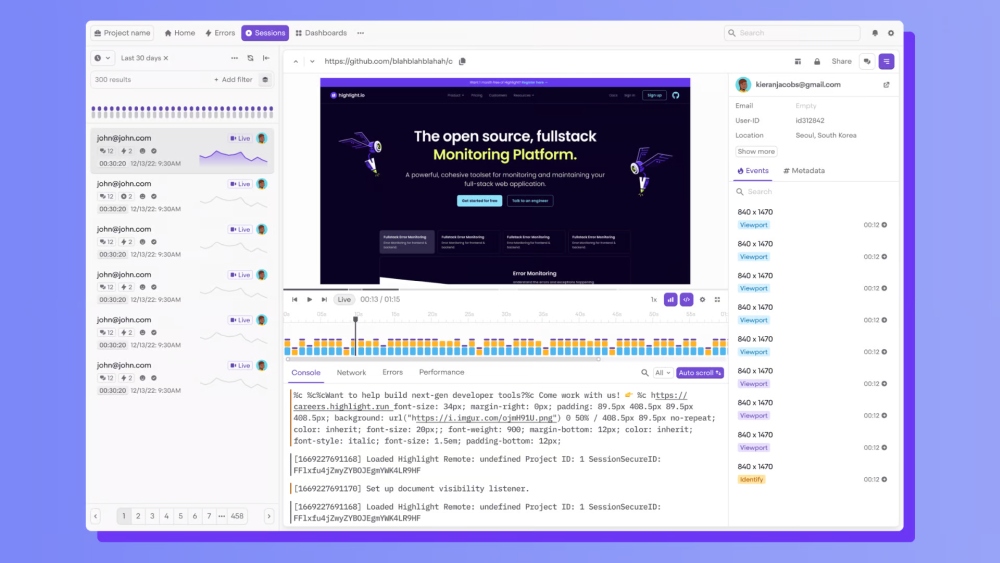
Highlight is a full-stack monitoring platform that offers not only log management but also session replay and error monitoring, making use of ClickHouse for data storage and retrieval. It is built to enable you to track the behaviour of your application, identify errors or bugs, analyze logs, and easily locate the root causes of performance issues.
With just two lines of code, you can start logging with this tool after installing it. It will immediately begin to collect logs from your application. These log messages and attributes can then be easily searched and queried. It also allows you to set alerts to your desired frequency for when logs reach your specified threshold. You will be notified via the supported channels which include email, Slack, Discord, or webhooks.
Highlight seamlessly integrates with all the popular modern frameworks such as Python, Golang, Node.js, React, Rails and many more. It allows you to visualize every single part of your infrastructure from user clicks to server errors in an understandable and actionable manner. It offers a free plan as well as a flexible pay-as-you-go pricing plan, and you can of course self-host it.
Highlight pros
- Flexible payment plan.
- Easy and quick to set up.
- Alerting capabilities are efficient.
- Visualization is offered in a clean UI.
- Seamlessly works with all the popular frameworks.
- Log querying and searching is straightforward and easy to perform.
Highlight cons
- It is not as battle tested as older tools.
Freemium log management tools
Freemium log management tools offer a cost-effective solution for organizations to manage log data. They provide free basic features and offer advanced capabilities through paid plans, enabling businesses to collect, store, analyze, and visualize logs for valuable insights and improved system performance.
1. Better Stack
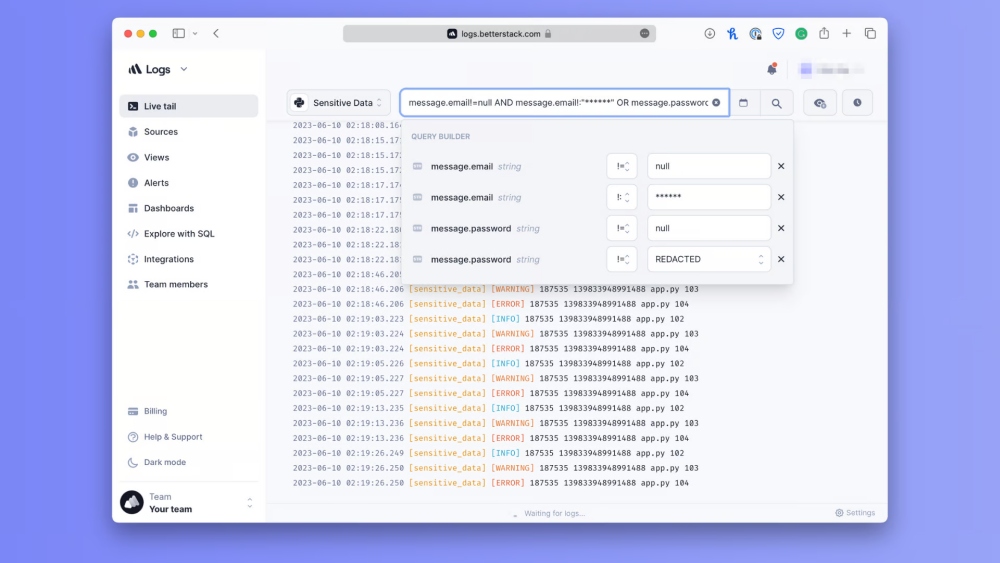
Better Stack is a comprehensive log management solution that enables you to collect, transport, visualize, analyze, monitor, store, and archive logs across your entire cloud infrastructure. It has the ability to convert plaintext logs into JSON for easier searching, and allows you to query your logs with SQL just as you would if you were querying a database. It is very fast, able to search and filter through massive amounts of logs in moments.
This tool seamlessly integrates with popular stacks (Kubernetes, Heroku, Logstash, Rails, Docker, AWS) for expanded monitoring options. Custom-built technology and ClickHouse storage enable efficient log management while optimizing costs. Better Stack offers simple, well-designed, highly customizable dashboards for you to visualize your data in the most comprehensive manner. It also employs the use of industry-standard best practices to ensure the total security of your data at every point.
One of the standout features of Better Stack is its built-in collaboration capabilities, facilitating teamwork in a Google Docs-like environment. You can save, share, archive code snippets and collaborate seamlessly in real-time with your colleagues. It also allows you to set anomaly detection alerts to make you immediately aware of any issues and be able to respond appropriately in a timely fashion.
It is available for free, giving you access to 1GB of storage per month, a 3-day data retention period, and the ability to collect data from 5 sources. If you want more capabilities, paid plans start at $24/month for 30GB of storage coupled with a 15-day retention. In addition to all these features, Better Stack has a dedicated technical support team to assist you with any issues you might have.
2. New Relic
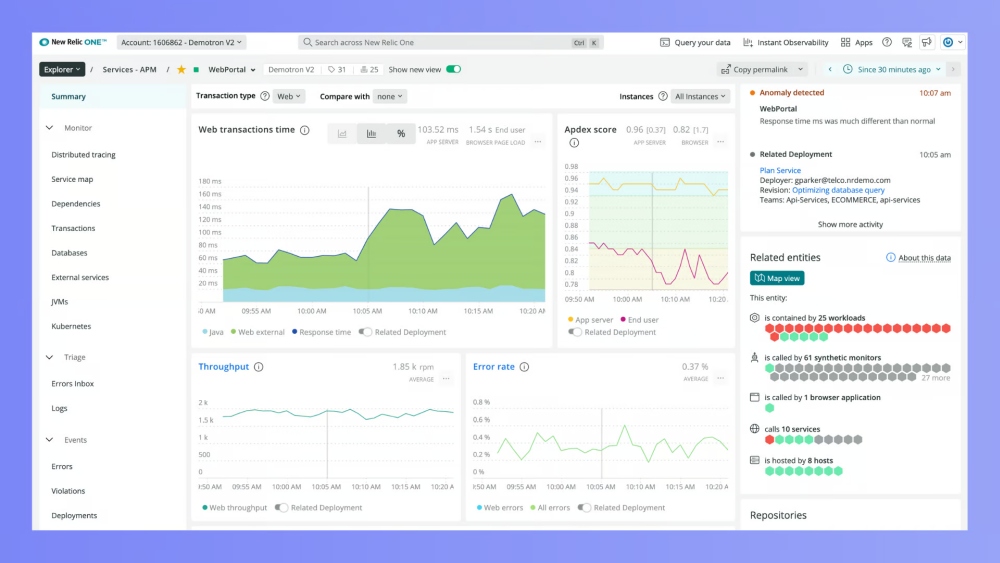
New Relic is a comprehensive observability platform that helps organizations monitor, troubleshoot, and optimize their applications and infrastructure. It offers real-time insights into the performance, availability, and health of software systems, allowing businesses to proactively identify and resolve issues. It offers a free forever plan with 100GBs/month data ingestion and one user access.
Comparing open source and paid log management tools
Log management tools can be categorized as either open-source or paid, each with its own distinct characteristics. The primary differences between these two types of tools lie in their licensing, cost models, hosting, setup, and features.
Licensing and cost models
Open source log management tools allow users to freely access and modify their source code. These tools are typically available without cost, enabling you to customize and extend them to suit your specific needs.
On the other hand, paid tools require users to purchase licenses, which grant specific usage rights and may involve ongoing subscription costs. In most cases, the source code is not available for viewing or modification, but a free trial or tier is often available to evaluate the tool before committing.
Hosting and setup
Open-source log management tools are usually self-hosted, meaning you are responsible for deploying and maintaining the tools on your own infrastructure. This provides a greater control and flexibility over the deployment environment. Many tools also offer a managed version where you can pay for hosting, management, and support if you wish to.
Paid log management tools are typically hosted by the provider, alleviating the burden and cost of setting up and managing the infrastructure. You can access the tools through a subscription or licensing agreement, allowing for quick and hassle-free deployment.
Features
While open-source log management tools offer a solid foundation, they usually have a more limited set of features compared to their paid counterparts. However, these tools often provide a high degree of customization and can be extended by leveraging solutions developed by the community.
Paid tools often come bundled with a comprehensive range of advanced features. These features may include sophisticated analytics, real-time monitoring, advanced search capabilities, and integration with other systems. Paid tools generally focus on delivering a feature-rich experience out-of-the-box.
Support
Support for open-source log management tools is typically community-driven. Users rely on community forums, documentation, and community-contributed resources for assistance and troubleshooting. However, some tools offer premium support for the core team as part of their managed deployment solution.
Paid log management tools commonly offer dedicated customer support. Users can access professional support services, including assistance with configuration, troubleshooting, and timely responses to inquiries.
When choosing between open-source and paid log management tools, you must consider factors such as the level of customization required, available resources, desired features, budget, and support needs. Both options have their own merits and can be selected based on the specific requirements and preferences of the organization.
Final thoughts
In this article, we highlighted the importance of log management, delved into the features, pros and cons of various open-source log management tools. We also discussed two freemium alternatives as options to consider if the open source tools don’t quite fit your needs.
Choosing the appropriate log management solution is crucial in gaining a comprehensive understanding of your architecture, and now more than ever, it is essential to make an informed decision that aligns with your business needs.
Thanks for reading!